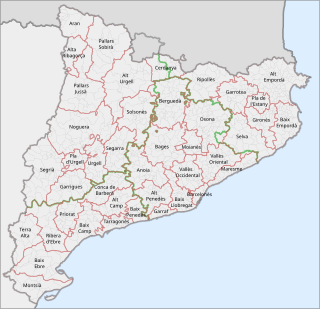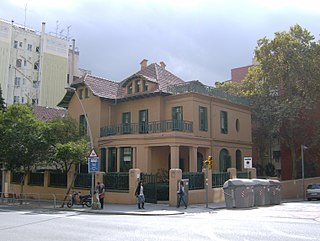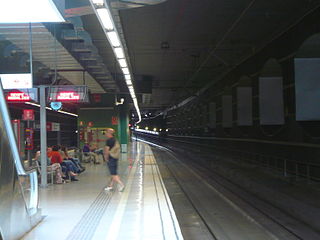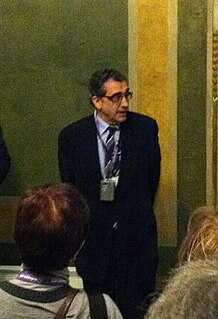Related Research Articles

The Institute for Catalan Studies, also known by the acronym IEC, is an academic institution which seeks to undertake research and study into "all elements of Catalan culture". It is based in Barcelona, Spain.

This is a list of the 42 comarques into which Catalonia is divided. A comarca is a group of municipalities, roughly equivalent to a county in the USA or a district in the UK. However, in the context of Catalonia, the term "county" can be a bit misleading, because in medieval Catalonia, aside from the kings of Aragon, the most important rulers were counts, notably the Counts of Barcelona and of Urgell. Comarques have no particular relation to the "counties" that were ruled by counts.

Joaquim Nadal i Farreras is a Spanish politician and historian from Catalonia. He is a professor at the University of Girona and was the Minister of Territorial Policy and Public Works of the Catalan Government, the Generalitat de Catalunya, from December 2003 to December 2010.

Josep Carner i Puigoriol, was a Spanish poet, journalist, playwright and translator. He was also known as the Prince of Catalan Poets. He was nominated for the Nobel Prize in Literature seven times.

The Metropolitan Transport Authority is a public consortium intended to coordinate the operation and project the expansion of the public transport system in the Barcelona metropolitan area. It is made up of the Government of Catalonia and local administrations. It has been known as ATM Àrea de Barcelona since 2003 to differentiate it from the other existing Catalan public transport authorities in the Girona, Camp de Tarragona and Lleida areas, which are also identified as ATM. As of January 2015, the ATM-managed public transport system comprises 50 different operating companies and serves 346 municipalities, accounting for a population of over 5.7 million.

The Library of Catalonia is the Catalan national library, located in Barcelona, Catalonia, Spain. The primary mission of the Library of Catalonia is to collect, preserve, and spread Catalan bibliographic production and that related to the Catalan linguistic area, to look after its conservation, and to spread its bibliographic heritage while maintaining the status of a center for research and consultation.

Barcelona El Clot-Aragó is a Rodalies de Catalunya station in El Camp de l'Arpa del Clot, in the Sant Martí district of Barcelona in Catalonia, Spain. It is served by Barcelona commuter rail service lines R1, R2 and R2 Nord, as well as Girona commuter rail service line RG1 and regional line R11. Passengers can commute here to Barcelona Metro station Clot. Like its metro counterpart, the station is completely underground, under Carrer d'Aragó and Avinguda Meridiana.

The R1 is a line of Rodalies de Catalunya's Barcelona commuter rail service, operated by Renfe Operadora. It runs northwards from the Barcelona area to the southern limits of the province of Girona, passing through the coastal Maresme region. Since 2014, some services have been extended further north towards Portbou, near the French border. These services are designated RG1 and are considered part of the Girona commuter rail service. The line had an annual ridership of 28 million in 2016, achieving an average weekday ridership of 102,214 according to 2008 data.

The R3 is a line of Rodalies de Catalunya's Barcelona commuter rail service, operated by Renfe Operadora. It runs northwards from the Barcelona area to the French border town of Latour-de-Carol, passing through the Vallès Oriental, Osona and Ripollès regions. With a total line length of 165.9 kilometres (103.1 mi), it extends notably beyond the limits of the Barcelona metropolitan area, reaching the Pyrenees mountains. According to 2008 data, the line's average weekday ridership is 22,841.

The R4 is a line of Rodalies de Catalunya's Barcelona commuter rail service, operated by Renfe Operadora. It runs northwards from the northern limits of the province of Tarragona to Barcelona, passing through the inland Alt Penedès region. The line then continues towards central Catalonia, describing a U-shaped route through the Barcelona area. According to 2008 data, the line's average weekday ridership is 105,935, the highest on any line of the Barcelona commuter rail service after the R2.

The R7 is a line of Rodalies de Catalunya's Barcelona commuter rail service, operated by Renfe Operadora. It links Sant Andreu Arenal railway station in northern Barcelona with Cerdanyola Universitat railway station, which serves the Bellaterra campus of the Autonomous University of Barcelona. The R7 shares tracks for most of its length with Barcelona commuter rail service lines R3 and R4, as well as regional rail line R12. According to 2010 data, the line's average weekday ridership is 8,140.

Airport T2 is both a Rodalies de Catalunya commuter rail station and a Barcelona Metro station serving terminal complex T2 of Barcelona–El Prat Airport. They are located adjacent to the airport's terminal T2B, in the municipality of El Prat de Llobregat, to the southwest of Barcelona, in Catalonia, Spain. The Rodalies de Catalunya station is the southern terminus of the current rail link coming from El Prat de Llobregat railway station. It is operated by Renfe Operadora and is served by Barcelona commuter rail service line R2 Nord. The metro station is on the airport branch of Barcelona Metro line 9 (L9) and is operated by Transports Metropolitans de Barcelona (TMB).

Rodalies de Catalunya is the main commuter and regional rail system in the Spanish autonomous community of Catalonia. It is administered by the Government of Catalonia and operated by the national rail operator Renfe Operadora. The system consists of 17 service lines chiefly centered in the Barcelona area, serving a total of 203 stations throughout Catalonia, with an average number of 1,000 trains running on it every day. In 2016, it had an annual ridership of 117 million.

The R8 is a line of Rodalies de Catalunya's Barcelona commuter rail service, operated by Renfe Operadora. It runs hourly between Martorell and Granollers across the Vallès Occidental region, spanning 40 kilometres (25 mi) and eight stations. The R8 primarily uses the Castellbisbal–Mollet-Sant Fost railway, as well as the Sant Vicenç de Calders–Vilafranca del Penedès–Barcelona and Barcelona–Cerbère railways on its southern and northern ends, respectively. It is currently the only line of the Barcelona commuter rail service entirely bypassing Barcelona. The trains operating on the line are Civia electrical multiple units (EMU).
The Llista d'encapçalaments de matèria en català (LEMAC) is a Catalan language controlled vocabulary that includes subject headings – linguistic expression - used by cataloguers to represent the thematic content of documents – a concept, event, name, or title- and that allows users to make a search in a catalogue, bibliography or index. LEMAC is created and maintained by the Servei de Normalització Bibliogrà
Òscar Vendrell Corrons is a proof-reader and author of textbooks and fiction works. He has signed some works under the pseudonym of Peter Walker.

El Prat de Llobregat or El Prat Estació is both a Rodalies de Catalunya and a Barcelona Metro station serving the suburb of El Prat de Llobregat, to the south-west of Barcelona, in Catalonia, Spain. It is on the conventional Madrid–Barcelona railway and is served by all trains on Barcelona commuter rail service lines R2 and R2 Nord, as well as some R2 Sud trains. Some trains on regional line R15 also call at the station. The metro station is on the airport branch of Barcelona Metro line 9 (L9) and is operated by Transports Metropolitans de Barcelona (TMB).

Francesc Fontbona de Vallescar is a Spanish art historian, writer, exhibition curator and specialist in Romanticism, Catalan Modernism and Noucentisme Arts. Fontbona is the author of many works of Catalan art history. Doctorate in Early modern period from the Universitat de Barcelona in 1987. He was director of Graphic section in National Library of Catalonia (1995-2013), and Chief executive-writer of art section in the Great Catalan Encyclopedia (1968–78). Francesc Fontbona is member of the Royal Catalan Academy of Fine Arts of Saint George, member of The Hispanic Society of America, member of the Institut d’Estudis Catalans and President of Patronat Institut Amatller d'Art Hispànic.

The Episcopal Public Library of Barcelona, also called the Episcopal Public Library of the Seminary of Barcelona is a library located in the building of the Conciliar Seminary of Barcelona. Founded in 1772, it is the oldest preserved public access library in the city of Barcelona, Spain. It houses a large collection of old and modern books, with about 360,000 volumes.
The RT1 is a line of Rodalies de Catalunya's Tarragona commuter rail service, operated by Renfe Operadora. It links Reus railway station in the city of Reus with Tarragona railway station, in the city center of Tarragona. The RT1 shares tracks for the entirety of its length with regional rail lines R14, R15 and R16, acting as a feeder line with additional services between these two areas. RT1 services started operating in 2014, becoming the first commuter service to use the Tarragona-Lleida railway, originally designed to serve regional as well as inter-city rail.
References
- ↑ FERRAN, Imma. «El Catàleg d'autoritats de noms i títols de Catalunya (CÀNTIC) ». BiD : textos universitaris de biblioteconomia i documentació, Núm. 22 (juny 2009) [Consulta: 1 gener 2013].
- ↑ Acord per a la millora i modernització del Sistema Bibliotecari de Catalunya en el període 2004-2007, aprovat pel Govern de la Generalitat de Catalunya el 20 de juliol de 2004.< "Archived copy" (PDF). Archived from the original (PDF) on 2012-04-12. Retrieved 2012-04-12.
{{cite web}}: CS1 maint: archived copy as title (link)>. [Consulta: 21 gener 2013]. - ↑ Informe per a la creació de la Llista d’Autoritats de Catalunya de noms i títols: requeriments i funcionalitats, octubre 2003
- ↑ 4_1993, de 18 de març, del sistema bibliotecari de Catalunya.pdf Llei 4/1193, de 18 de març, del sistema bibliotecari de Catalunya [ permanent dead link ]
- ↑ Regles angloamericanes de catalogació. 2a ed. rev. de 2002, actualització de 2005. Barcelona : Biblioteca de Catalunya, cop. 2008
- ↑ Concrecions a les AACR2 Part II (Encapçalaments, títols uniformes, referències), Ed. 2008. Barcelona : Biblioteca de Catalunya, 2008-
- ↑ Format Marc 21 per a dades d’autoritat Ed. anglesa, Ed. concisa catalana
- ↑ Manual CANTIC, actualització 2010